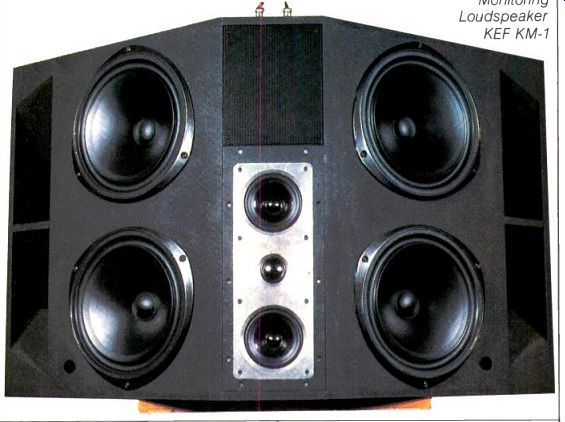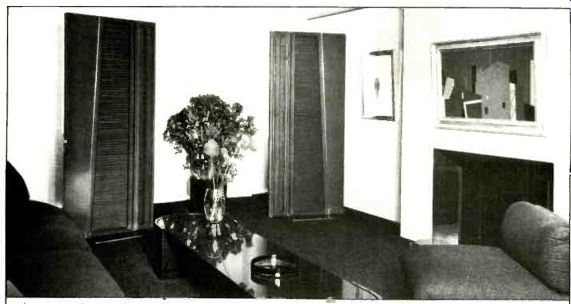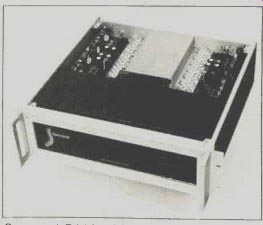CONVENTION( AL) GEAR

------- Monitoring Loudspeaker KEF KM-1
Since I devoted last month's column to the introduction of the Compact Disc at the 1983 SCES, here I'll report on the conventional audio equipment that caught my eye.
Whether our hi-fi technology be analog or digital, music will still have to be reproduced through loudspeakers, and at the SCES there were legions of them in every size, shape and form.
At the KEF room, old friend Raymond Cooke, managing director of KEF and president-elect of the Audio Engineering Society, was beaming with pride as he demonstrated his new KM-1 monitoring loudspeaker built for the British Broadcasting Corporation.
This KM-1 is an absolute brute of a speaker, an all-out attack on the problem of producing a monitor with high output and high quality sound. One of the new breed of active loudspeakers, it has an integral amplifier of more than 1,200 watts from eight output sections and powering seven drive units. Re member-this is per speaker. With a frequency response of 30 Hz to 20 kHz
±2 dB, the KM-1 can reach 120 dB SPL on program peaks. This speaker system is big, measuring 301/2 in. H x 523/4 in. W x 26 in. D. Mounted on a pedestal, the KM-1s weigh 264 pounds each. The room in which they were played at SCES was too small to do them justice, but I heard some mighty impressive sounds with a hint of the speakers' awesome power. If you have just made a killing in pork bellies, then the KM-1 can be yours for a mere $32,000 the pair.
Certainly one of the most unusual speakers was the system manufactured by Apogee Acoustics Inc. of Nor wood, Mass. Would you believe a full-range ribbon loudspeaker? As you know, up to now, ribbon drivers have mainly been used as tweeters, with a few mid-range units operating from about 600 Hz upward. The Apogee is an imposing 80 in. H x 35 in. W, but it is only four inches in depth. Each speaker has a steel framework to sup port a proprietary ultra-high-intensity magnetic drive system and each weighs over 300 pounds. The woofer ribbon is trapezoidal in shape so that resonances are staggered to avoid peaks. The special, corrugated aluminum alloy, two-inch wide mid-range ribbon is 80 inches long, and the half-inch wide tweeter ribbon is the same length and made of the same material.
There are coupling transformers and a passive network with crossover points at 400 Hz and 3.5 kHz. The speakers are of medium efficiency and are de signed to be biamplified. The Apogee is said to be capable of producing an SPL of 115 dB at four meters when driven by a pair of 100 watt per channel stereo amplifiers. Frequency response is claimed to be from below 30 Hz to beyond 30 kHz, with extremely low distortion. At the show, the Apogee ribbon speakers were driven by two Levinson ML-3 amplifiers and ML-6A pre-amps. Along with some other members of the audio press corp, I had heard a demonstration of proto type Apogee speakers in a New York apartment and we were all quite impressed. At the show the production model, with added refinements, had a seamlessly smooth quality of reproduction which was outstanding for its lack of coloration across the music spectrum. As you might expect with ribbon speakers, transient attack was lightning-fast and recordings like Real-Time Records Hot Stix--a tour de force in drum work--were reproduced with spectacular realism. Of course, the big question was whether the Apogee speakers could really reproduce low frequencies and high SPL. The "punch in the stomach" bass drum in the Telarc recording of Tchaikovsky's Cos sack Dance was very convincing evidence of the Apogee's low frequency capabilities. The 32-foot organ pedal notes I recorded on the Crystal Clear Virgill Fox discs were reproduced accurately with great sonority and room-shaking authority. With voice, with large-scale orchestral works, with solo instruments, and with jazz and pop groups, the Apogee full-range ribbon loudspeaker afforded a natural sound quality of compelling realism. Price of a pair 's $6,100.
Some people are so taken with CDs that they are sounding an early death knell for analog records. Many feel that the CD will make a significant impact on the analog market within a year and make really serious inroads in about three years. Could be-but you would never have guessed that analog re cords were in any jeopardy, judging by the considerable number of new phonograph products introduced at the SCES. Perhaps it would be best to paraphrase General MacArthur: "Old analog recordings will never die, they'll just fade away." Remember, in some parts of the world 78-rpm records are still spinning.

--------- Apogee Acoustics Loudspeaker
New phonograph cartridges were introduced by quite a few companies. Shure had a new line, headed by their V-15 Type V MR. The MR designates "Micro Ridge Tip," whose smaller tracing radius is said to reduce harmonic and intermodulation distortion. Present Type V cartridges can be updated by obtaining an MR replacement stylus assembly.
Goldring of England was proudly showing their new Electro Two moving-coil phono cartridge, whose high out put obviates the use of step-up trans formers or head amps. The cartridge features a van den Hul stylus, and is the first moving-coil cartridge ever manufactured in England. Price has been set at $300.
The well-known Decca cartridge is also now available with a van den Hul stylus. Marketed by Audio Access, it claims superior tracking, higher definition, better transient response, and total elimination of microphonics.
Accuphase showed their AC-2 moving coil cartridge with such features as a tubular sapphire cantilever, samarium cobalt magnets, and die-cast aluminum alloy cartridge housing. The AC-2 is claimed to have a frequency response up to 60 kHz, channel separation of 31 dB at 1 kHz, and channel balance within 0.5 dB.
Evidently Goldmund doesn't think analog records are a dying technology either. They introduced a "dream turn table," the Goldmund Reference. With its special stand, it weighs in at 200 pounds, has a suspended weight of 80 pounds, and uses a 35-pound turntable platter. Goldmund claims the best speed stability ever offered--0.01%.
The unit features the Goldmund T3 lateral-tracking tonearm, and a programmable computer control for all functions. This "analog fantasy" can be yours for a mere $11,000! An English turntable called the Rock aroused considerable interest. You all probably saw turntables featuring concrete bases some years ago. The Rock turntable uses a special cast-stone agglomerate base which is mounted on a heavy suspension. The turntable platter itself is made from the same material and is said to have the same resonant frequency as a vinyl record. If you recall the viscous fluid damper of the SME arms, there is a similar device on the arm supplied with this turntable.
The difference is that the Rock's paddle is at the other end of the arm, beyond the cartridge from the pivot.
The oil-filled damping trough is arc shaped and swings into position over the record for use. During play, the rotating record can be sharply rapped, not only with no loss of stability but also with no production of microphonics. The Rock will be imported by Essence of Lincoln, Neb.
Finally, by the time you read this, SOTA will have started production of their Star Sapphire vacuum-platter turntable. Several other improvements have also been incorporated, including a computer-generated optical stroboscope, and the unit now features a separate power supply. They will also offer a mounting board for the Souther arm, as will the Oracle turntable folks.
With the 90 dB dynamic range of CDs, big-brute, high-wattage amplifiers are in vogue again. Perreaux was showing a monster amplifier which is said to have an output of 800 watts per channel into 8 ohms! Frank Dickinson, my recording associate, who does much digital recording around New York, has the professional version of this amplifier, with XLR inputs and out puts, balanced connections, etc. He tells me that this is one of the few amplifiers which can withstand the rig ors of digital recording. Price is stated to be slightly under $3,000.
Accuphase was demonstrating their P-600 stereo amplifier, an 85-pound unit which has an output of 300 watts per channel into 8 ohms and which can be bridged for an output of 1,000 watts monophonic into 8 ohms. The P-600 has special circuitry that permits operation into 1 ohm with an output of 450 watts per channel! Harmonic distortion is claimed to be less than 0.01% with 4 to 16 ohms. The amplifier has a digital peak-power display, using a 12-bit ND converter and a 4-bit micro processor. This facility features a Hold Time circuit which can keep the peak-level reading for 30 minutes and thus show the maximum level on one side of a record. This amplifier can also be operated into a 600-ohm balanced line input.

-------- Spectral DMA-100 Class A Amplifier
Spectral has been researching the design of a Class-A amplifier for some years, and finally they unveiled it in the form of their DMA-100. This amplifier claims 100 watts per channel into 8 ohms with a power bandwidth of 1 MHz and a slew rate exceeding 500 V/µS. The unit will drive loads as low as 1.2 ohms with an output of 270 watts per channel. The DMA-100 is also said to recover instantaneously from over loads as high as 20 dB. In what appears to be a growing trend, this amplifier can also be operated in a balanced configuration. The DMA-100 will sell for $3,195.
Counterpoint entered the world of exotic amplifiers with their SA-4 mono tube amplifier. An output-transformer-less design, it has an output of 100 watts per channel into 8 ohms, with Class-A operation up to 25 watts. A pair of these mono amplifiers will sell for $4,000.
As usual, more products at the SCES than one could possibly cover. I'll try to slip in mentions of some other loud speakers and assorted items in forth coming columns.
-----------
(Source: Audio magazine, Oct. 1983; Bert Whyte )
Also see:
Stax Electrostatic Earspeakers (ad, Aug. 1984)
Stax SRX-II Electrostatic Earspeaker system (ad, April 1975)
= = = =